Professional Research and Communication Assignment Solution
VerifiedAdded on 2023/06/08
|9
|1964
|425
Homework Assignment
AI Summary
This assignment addresses key concepts in professional research and communication. It begins by critiquing the validity of survey data using the Likert scale, highlighting potential issues with data collection and response interpretation, and suggesting improvements for customer satisfaction surveys. The assignment then analyzes the election process of a polling company, considering factors like voter eligibility and the impact of different voting methods. It further categorizes quantitative data types (nominal, ordinal, interval, and ratio) through examples like car counts, mobile phone types, and temperature scales. Finally, the assignment explores different research study designs, including non-experimental descriptive, quasi-experimental, and experimental studies, emphasizing their application in educational contexts to evaluate student performance. References supporting the analysis are provided.
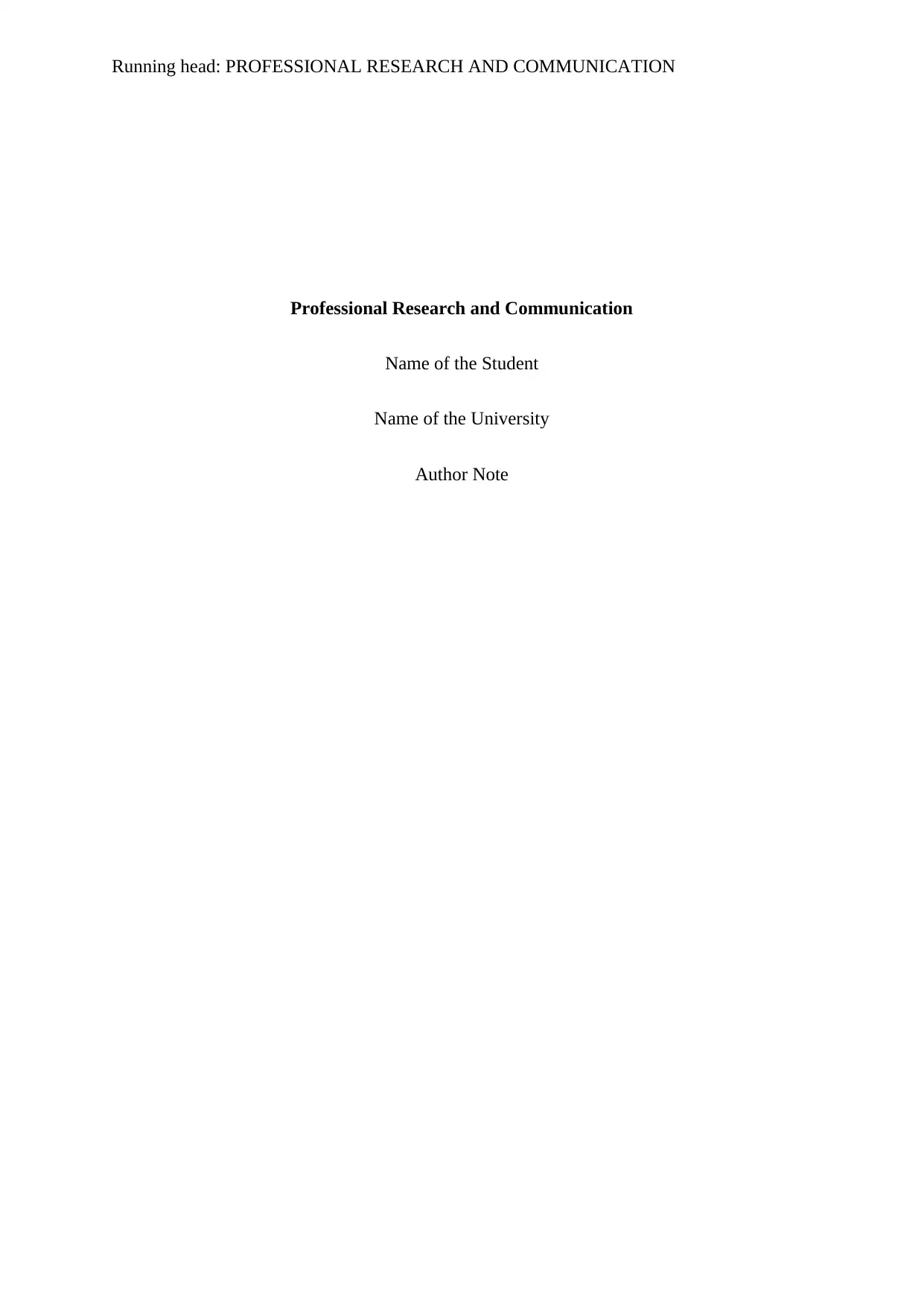
Running head: PROFESSIONAL RESEARCH AND COMMUNICATION
Professional Research and Communication
Name of the Student
Name of the University
Author Note
Professional Research and Communication
Name of the Student
Name of the University
Author Note
Paraphrase This Document
Need a fresh take? Get an instant paraphrase of this document with our AI Paraphraser
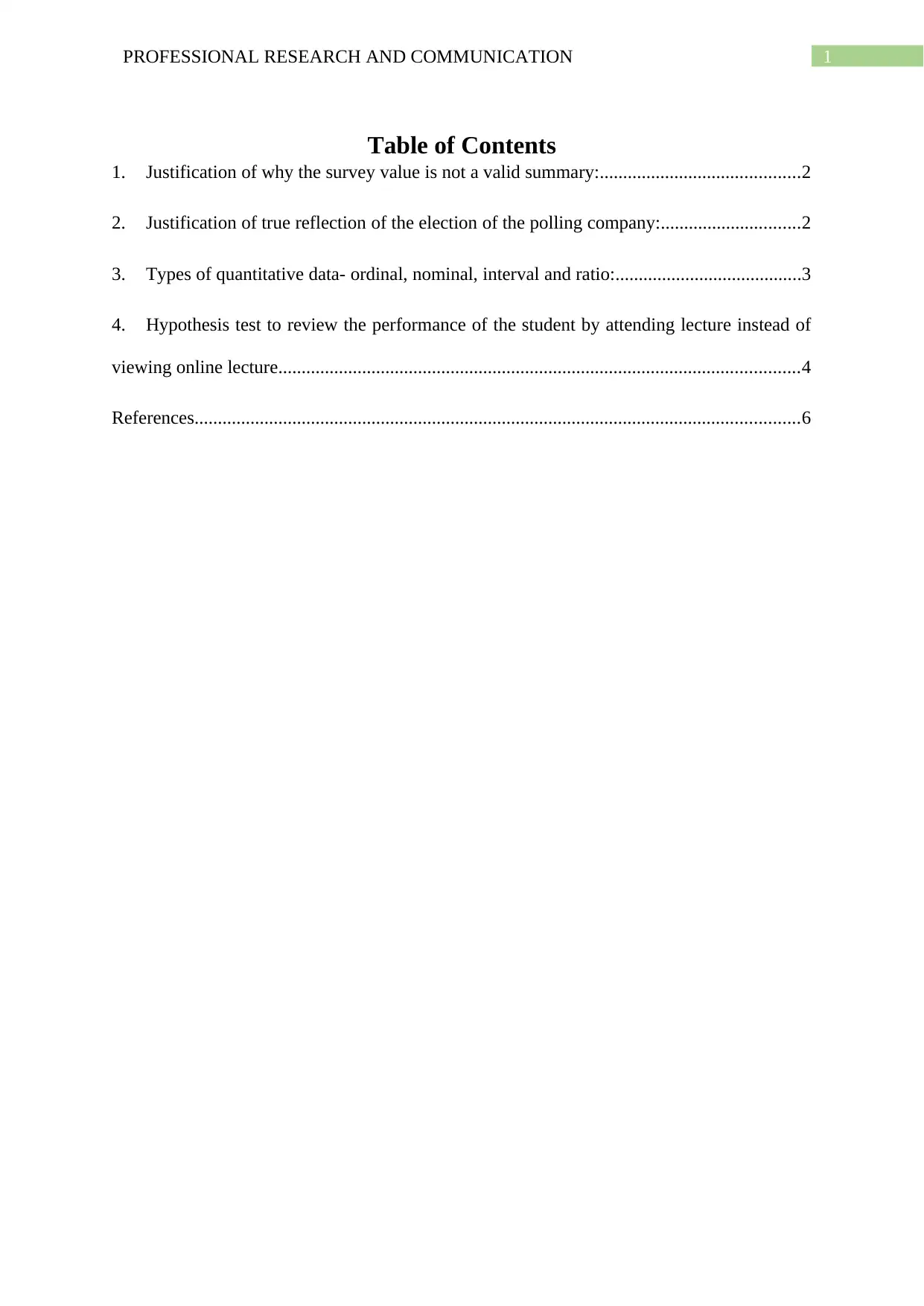
1PROFESSIONAL RESEARCH AND COMMUNICATION
Table of Contents
1. Justification of why the survey value is not a valid summary:...........................................2
2. Justification of true reflection of the election of the polling company:..............................2
3. Types of quantitative data- ordinal, nominal, interval and ratio:........................................3
4. Hypothesis test to review the performance of the student by attending lecture instead of
viewing online lecture................................................................................................................4
References..................................................................................................................................6
Table of Contents
1. Justification of why the survey value is not a valid summary:...........................................2
2. Justification of true reflection of the election of the polling company:..............................2
3. Types of quantitative data- ordinal, nominal, interval and ratio:........................................3
4. Hypothesis test to review the performance of the student by attending lecture instead of
viewing online lecture................................................................................................................4
References..................................................................................................................................6
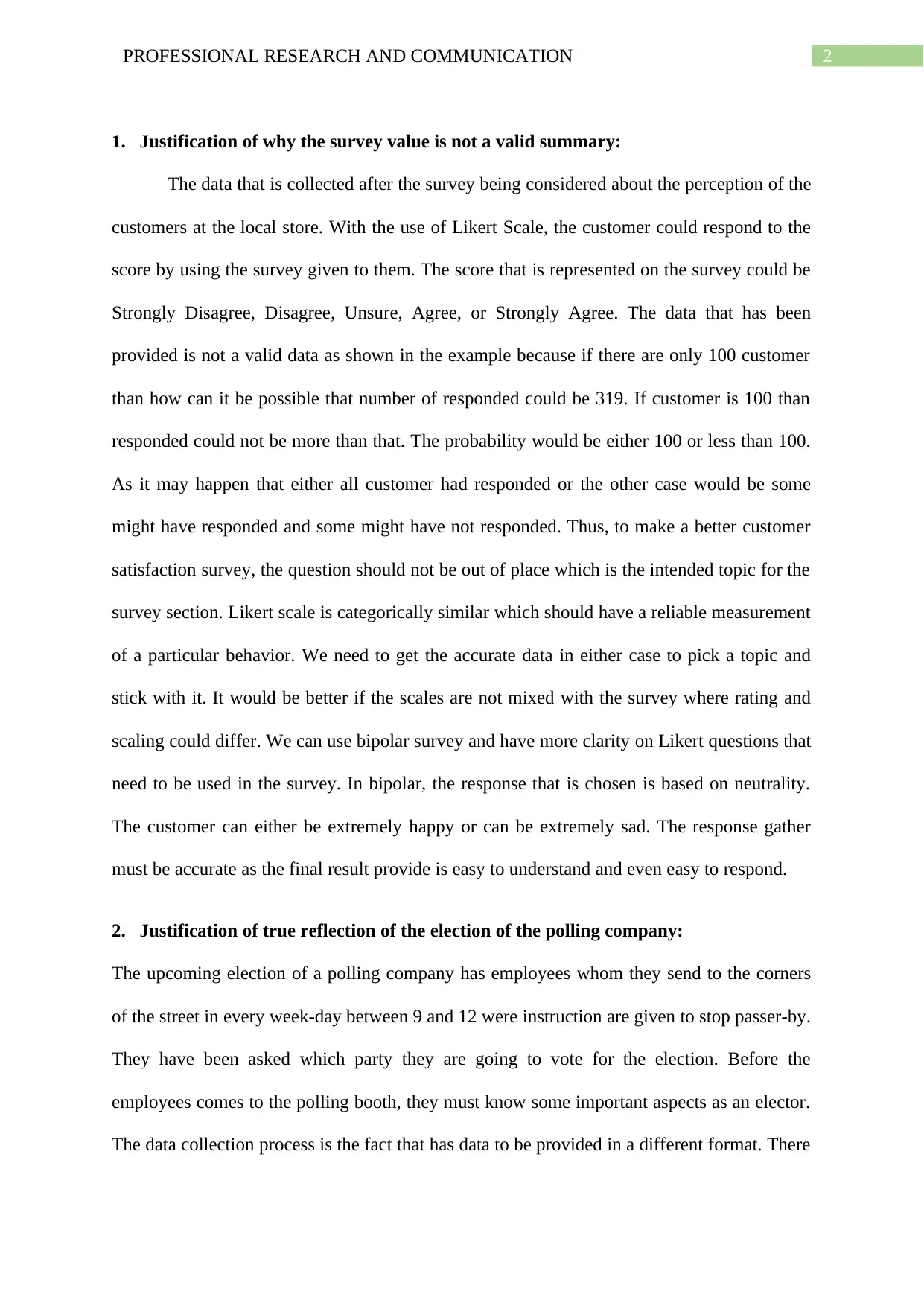
2PROFESSIONAL RESEARCH AND COMMUNICATION
1. Justification of why the survey value is not a valid summary:
The data that is collected after the survey being considered about the perception of the
customers at the local store. With the use of Likert Scale, the customer could respond to the
score by using the survey given to them. The score that is represented on the survey could be
Strongly Disagree, Disagree, Unsure, Agree, or Strongly Agree. The data that has been
provided is not a valid data as shown in the example because if there are only 100 customer
than how can it be possible that number of responded could be 319. If customer is 100 than
responded could not be more than that. The probability would be either 100 or less than 100.
As it may happen that either all customer had responded or the other case would be some
might have responded and some might have not responded. Thus, to make a better customer
satisfaction survey, the question should not be out of place which is the intended topic for the
survey section. Likert scale is categorically similar which should have a reliable measurement
of a particular behavior. We need to get the accurate data in either case to pick a topic and
stick with it. It would be better if the scales are not mixed with the survey where rating and
scaling could differ. We can use bipolar survey and have more clarity on Likert questions that
need to be used in the survey. In bipolar, the response that is chosen is based on neutrality.
The customer can either be extremely happy or can be extremely sad. The response gather
must be accurate as the final result provide is easy to understand and even easy to respond.
2. Justification of true reflection of the election of the polling company:
The upcoming election of a polling company has employees whom they send to the corners
of the street in every week-day between 9 and 12 were instruction are given to stop passer-by.
They have been asked which party they are going to vote for the election. Before the
employees comes to the polling booth, they must know some important aspects as an elector.
The data collection process is the fact that has data to be provided in a different format. There
1. Justification of why the survey value is not a valid summary:
The data that is collected after the survey being considered about the perception of the
customers at the local store. With the use of Likert Scale, the customer could respond to the
score by using the survey given to them. The score that is represented on the survey could be
Strongly Disagree, Disagree, Unsure, Agree, or Strongly Agree. The data that has been
provided is not a valid data as shown in the example because if there are only 100 customer
than how can it be possible that number of responded could be 319. If customer is 100 than
responded could not be more than that. The probability would be either 100 or less than 100.
As it may happen that either all customer had responded or the other case would be some
might have responded and some might have not responded. Thus, to make a better customer
satisfaction survey, the question should not be out of place which is the intended topic for the
survey section. Likert scale is categorically similar which should have a reliable measurement
of a particular behavior. We need to get the accurate data in either case to pick a topic and
stick with it. It would be better if the scales are not mixed with the survey where rating and
scaling could differ. We can use bipolar survey and have more clarity on Likert questions that
need to be used in the survey. In bipolar, the response that is chosen is based on neutrality.
The customer can either be extremely happy or can be extremely sad. The response gather
must be accurate as the final result provide is easy to understand and even easy to respond.
2. Justification of true reflection of the election of the polling company:
The upcoming election of a polling company has employees whom they send to the corners
of the street in every week-day between 9 and 12 were instruction are given to stop passer-by.
They have been asked which party they are going to vote for the election. Before the
employees comes to the polling booth, they must know some important aspects as an elector.
The data collection process is the fact that has data to be provided in a different format. There
⊘ This is a preview!⊘
Do you want full access?
Subscribe today to unlock all pages.

Trusted by 1+ million students worldwide
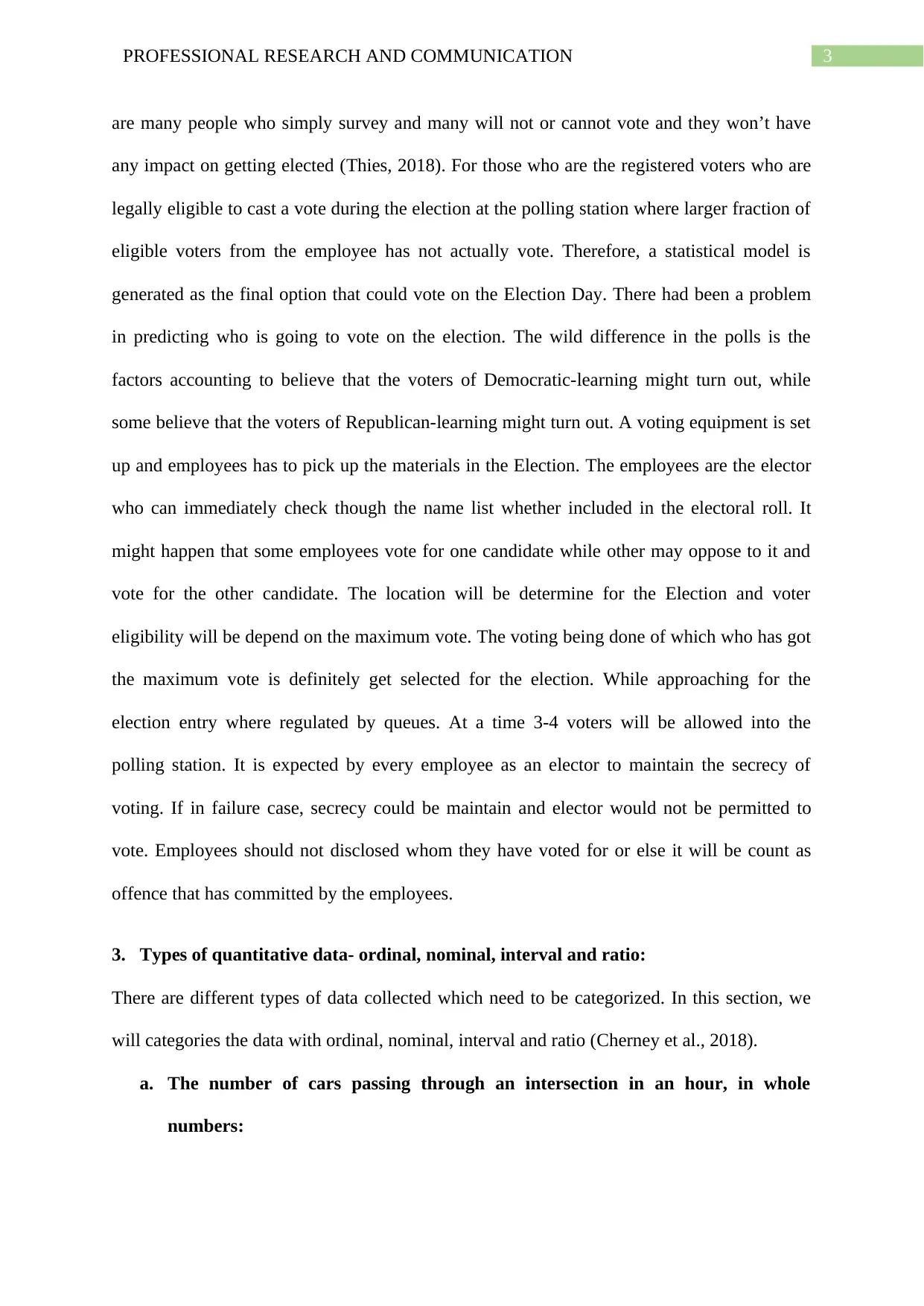
3PROFESSIONAL RESEARCH AND COMMUNICATION
are many people who simply survey and many will not or cannot vote and they won’t have
any impact on getting elected (Thies, 2018). For those who are the registered voters who are
legally eligible to cast a vote during the election at the polling station where larger fraction of
eligible voters from the employee has not actually vote. Therefore, a statistical model is
generated as the final option that could vote on the Election Day. There had been a problem
in predicting who is going to vote on the election. The wild difference in the polls is the
factors accounting to believe that the voters of Democratic-learning might turn out, while
some believe that the voters of Republican-learning might turn out. A voting equipment is set
up and employees has to pick up the materials in the Election. The employees are the elector
who can immediately check though the name list whether included in the electoral roll. It
might happen that some employees vote for one candidate while other may oppose to it and
vote for the other candidate. The location will be determine for the Election and voter
eligibility will be depend on the maximum vote. The voting being done of which who has got
the maximum vote is definitely get selected for the election. While approaching for the
election entry where regulated by queues. At a time 3-4 voters will be allowed into the
polling station. It is expected by every employee as an elector to maintain the secrecy of
voting. If in failure case, secrecy could be maintain and elector would not be permitted to
vote. Employees should not disclosed whom they have voted for or else it will be count as
offence that has committed by the employees.
3. Types of quantitative data- ordinal, nominal, interval and ratio:
There are different types of data collected which need to be categorized. In this section, we
will categories the data with ordinal, nominal, interval and ratio (Cherney et al., 2018).
a. The number of cars passing through an intersection in an hour, in whole
numbers:
are many people who simply survey and many will not or cannot vote and they won’t have
any impact on getting elected (Thies, 2018). For those who are the registered voters who are
legally eligible to cast a vote during the election at the polling station where larger fraction of
eligible voters from the employee has not actually vote. Therefore, a statistical model is
generated as the final option that could vote on the Election Day. There had been a problem
in predicting who is going to vote on the election. The wild difference in the polls is the
factors accounting to believe that the voters of Democratic-learning might turn out, while
some believe that the voters of Republican-learning might turn out. A voting equipment is set
up and employees has to pick up the materials in the Election. The employees are the elector
who can immediately check though the name list whether included in the electoral roll. It
might happen that some employees vote for one candidate while other may oppose to it and
vote for the other candidate. The location will be determine for the Election and voter
eligibility will be depend on the maximum vote. The voting being done of which who has got
the maximum vote is definitely get selected for the election. While approaching for the
election entry where regulated by queues. At a time 3-4 voters will be allowed into the
polling station. It is expected by every employee as an elector to maintain the secrecy of
voting. If in failure case, secrecy could be maintain and elector would not be permitted to
vote. Employees should not disclosed whom they have voted for or else it will be count as
offence that has committed by the employees.
3. Types of quantitative data- ordinal, nominal, interval and ratio:
There are different types of data collected which need to be categorized. In this section, we
will categories the data with ordinal, nominal, interval and ratio (Cherney et al., 2018).
a. The number of cars passing through an intersection in an hour, in whole
numbers:
Paraphrase This Document
Need a fresh take? Get an instant paraphrase of this document with our AI Paraphraser
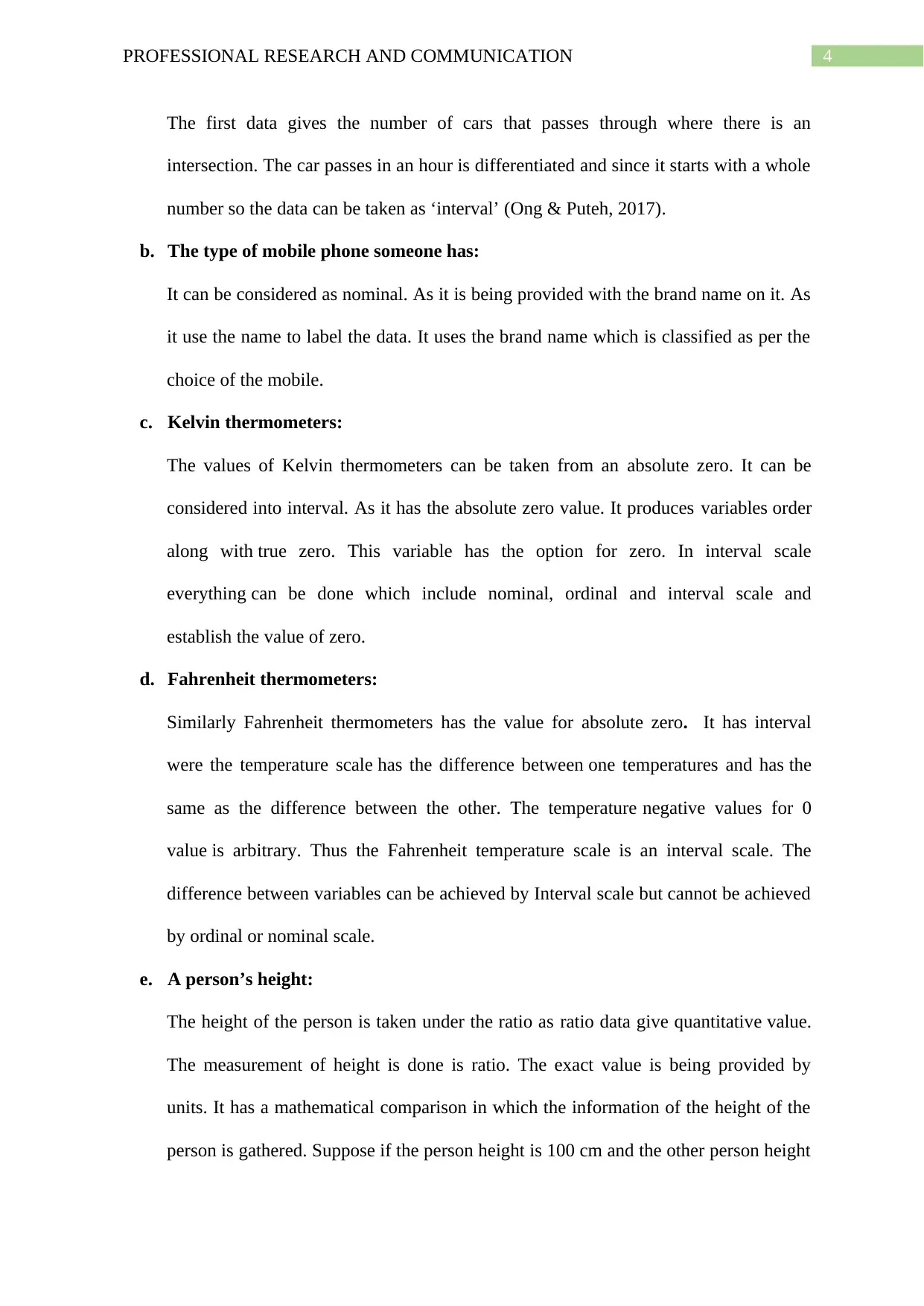
4PROFESSIONAL RESEARCH AND COMMUNICATION
The first data gives the number of cars that passes through where there is an
intersection. The car passes in an hour is differentiated and since it starts with a whole
number so the data can be taken as ‘interval’ (Ong & Puteh, 2017).
b. The type of mobile phone someone has:
It can be considered as nominal. As it is being provided with the brand name on it. As
it use the name to label the data. It uses the brand name which is classified as per the
choice of the mobile.
c. Kelvin thermometers:
The values of Kelvin thermometers can be taken from an absolute zero. It can be
considered into interval. As it has the absolute zero value. It produces variables order
along with true zero. This variable has the option for zero. In interval scale
everything can be done which include nominal, ordinal and interval scale and
establish the value of zero.
d. Fahrenheit thermometers:
Similarly Fahrenheit thermometers has the value for absolute zero. It has interval
were the temperature scale has the difference between one temperatures and has the
same as the difference between the other. The temperature negative values for 0
value is arbitrary. Thus the Fahrenheit temperature scale is an interval scale. The
difference between variables can be achieved by Interval scale but cannot be achieved
by ordinal or nominal scale.
e. A person’s height:
The height of the person is taken under the ratio as ratio data give quantitative value.
The measurement of height is done is ratio. The exact value is being provided by
units. It has a mathematical comparison in which the information of the height of the
person is gathered. Suppose if the person height is 100 cm and the other person height
The first data gives the number of cars that passes through where there is an
intersection. The car passes in an hour is differentiated and since it starts with a whole
number so the data can be taken as ‘interval’ (Ong & Puteh, 2017).
b. The type of mobile phone someone has:
It can be considered as nominal. As it is being provided with the brand name on it. As
it use the name to label the data. It uses the brand name which is classified as per the
choice of the mobile.
c. Kelvin thermometers:
The values of Kelvin thermometers can be taken from an absolute zero. It can be
considered into interval. As it has the absolute zero value. It produces variables order
along with true zero. This variable has the option for zero. In interval scale
everything can be done which include nominal, ordinal and interval scale and
establish the value of zero.
d. Fahrenheit thermometers:
Similarly Fahrenheit thermometers has the value for absolute zero. It has interval
were the temperature scale has the difference between one temperatures and has the
same as the difference between the other. The temperature negative values for 0
value is arbitrary. Thus the Fahrenheit temperature scale is an interval scale. The
difference between variables can be achieved by Interval scale but cannot be achieved
by ordinal or nominal scale.
e. A person’s height:
The height of the person is taken under the ratio as ratio data give quantitative value.
The measurement of height is done is ratio. The exact value is being provided by
units. It has a mathematical comparison in which the information of the height of the
person is gathered. Suppose if the person height is 100 cm and the other person height
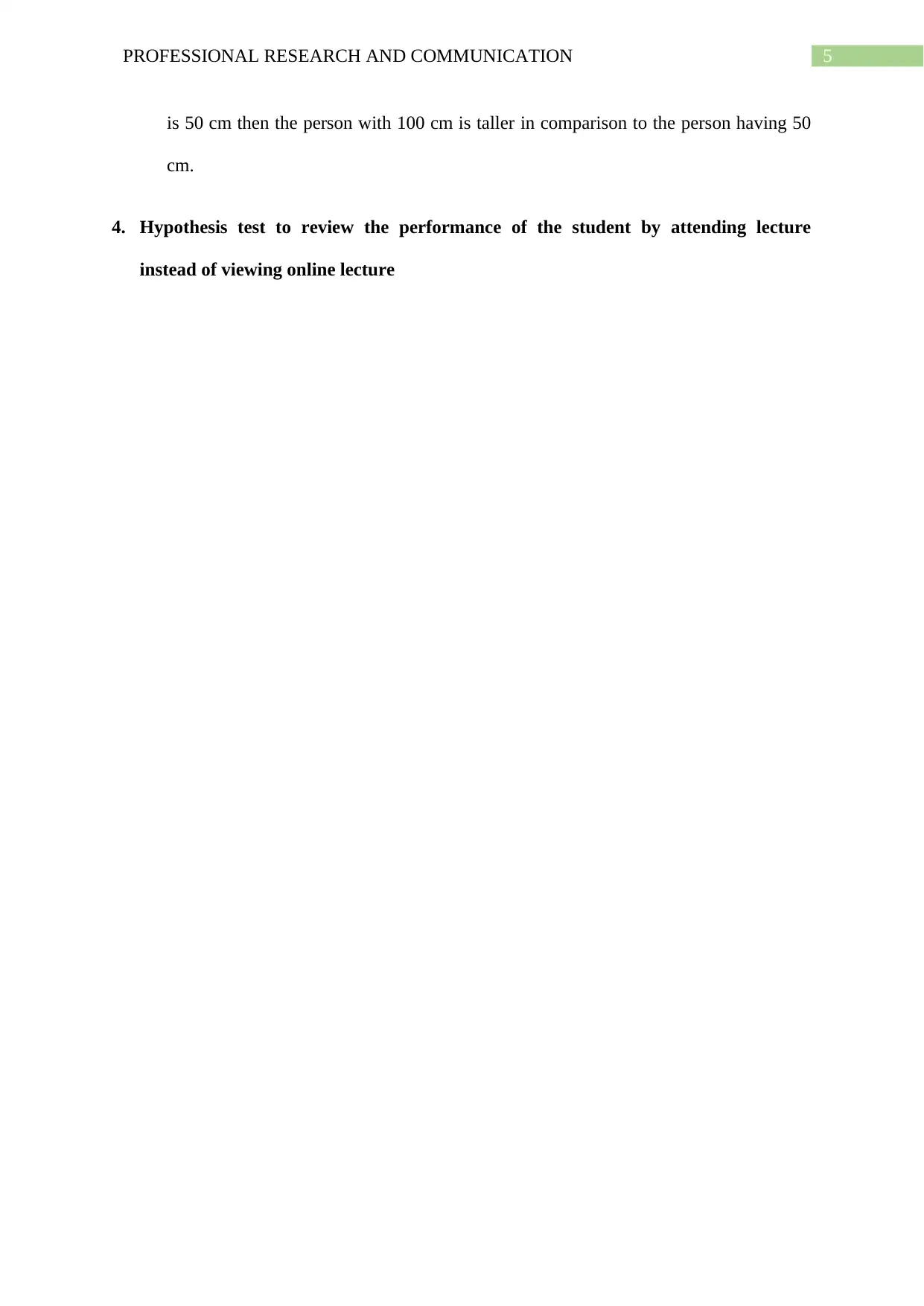
5PROFESSIONAL RESEARCH AND COMMUNICATION
is 50 cm then the person with 100 cm is taller in comparison to the person having 50
cm.
4. Hypothesis test to review the performance of the student by attending lecture
instead of viewing online lecture
is 50 cm then the person with 100 cm is taller in comparison to the person having 50
cm.
4. Hypothesis test to review the performance of the student by attending lecture
instead of viewing online lecture
⊘ This is a preview!⊘
Do you want full access?
Subscribe today to unlock all pages.

Trusted by 1+ million students worldwide
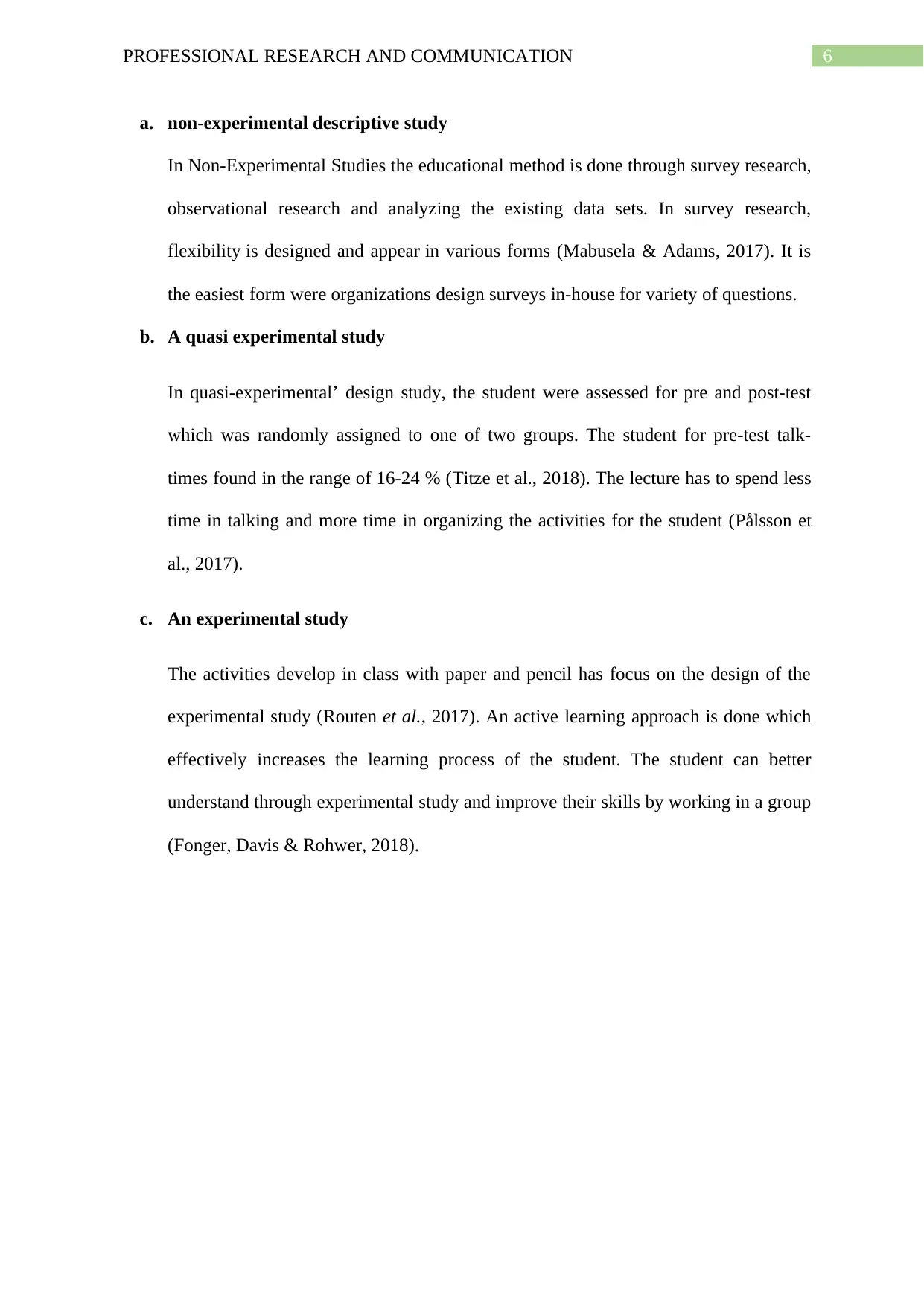
6PROFESSIONAL RESEARCH AND COMMUNICATION
a. non-experimental descriptive study
In Non-Experimental Studies the educational method is done through survey research,
observational research and analyzing the existing data sets. In survey research,
flexibility is designed and appear in various forms (Mabusela & Adams, 2017). It is
the easiest form were organizations design surveys in-house for variety of questions.
b. A quasi experimental study
In quasi-experimental’ design study, the student were assessed for pre and post-test
which was randomly assigned to one of two groups. The student for pre-test talk-
times found in the range of 16-24 % (Titze et al., 2018). The lecture has to spend less
time in talking and more time in organizing the activities for the student (Pålsson et
al., 2017).
c. An experimental study
The activities develop in class with paper and pencil has focus on the design of the
experimental study (Routen et al., 2017). An active learning approach is done which
effectively increases the learning process of the student. The student can better
understand through experimental study and improve their skills by working in a group
(Fonger, Davis & Rohwer, 2018).
a. non-experimental descriptive study
In Non-Experimental Studies the educational method is done through survey research,
observational research and analyzing the existing data sets. In survey research,
flexibility is designed and appear in various forms (Mabusela & Adams, 2017). It is
the easiest form were organizations design surveys in-house for variety of questions.
b. A quasi experimental study
In quasi-experimental’ design study, the student were assessed for pre and post-test
which was randomly assigned to one of two groups. The student for pre-test talk-
times found in the range of 16-24 % (Titze et al., 2018). The lecture has to spend less
time in talking and more time in organizing the activities for the student (Pålsson et
al., 2017).
c. An experimental study
The activities develop in class with paper and pencil has focus on the design of the
experimental study (Routen et al., 2017). An active learning approach is done which
effectively increases the learning process of the student. The student can better
understand through experimental study and improve their skills by working in a group
(Fonger, Davis & Rohwer, 2018).
Paraphrase This Document
Need a fresh take? Get an instant paraphrase of this document with our AI Paraphraser
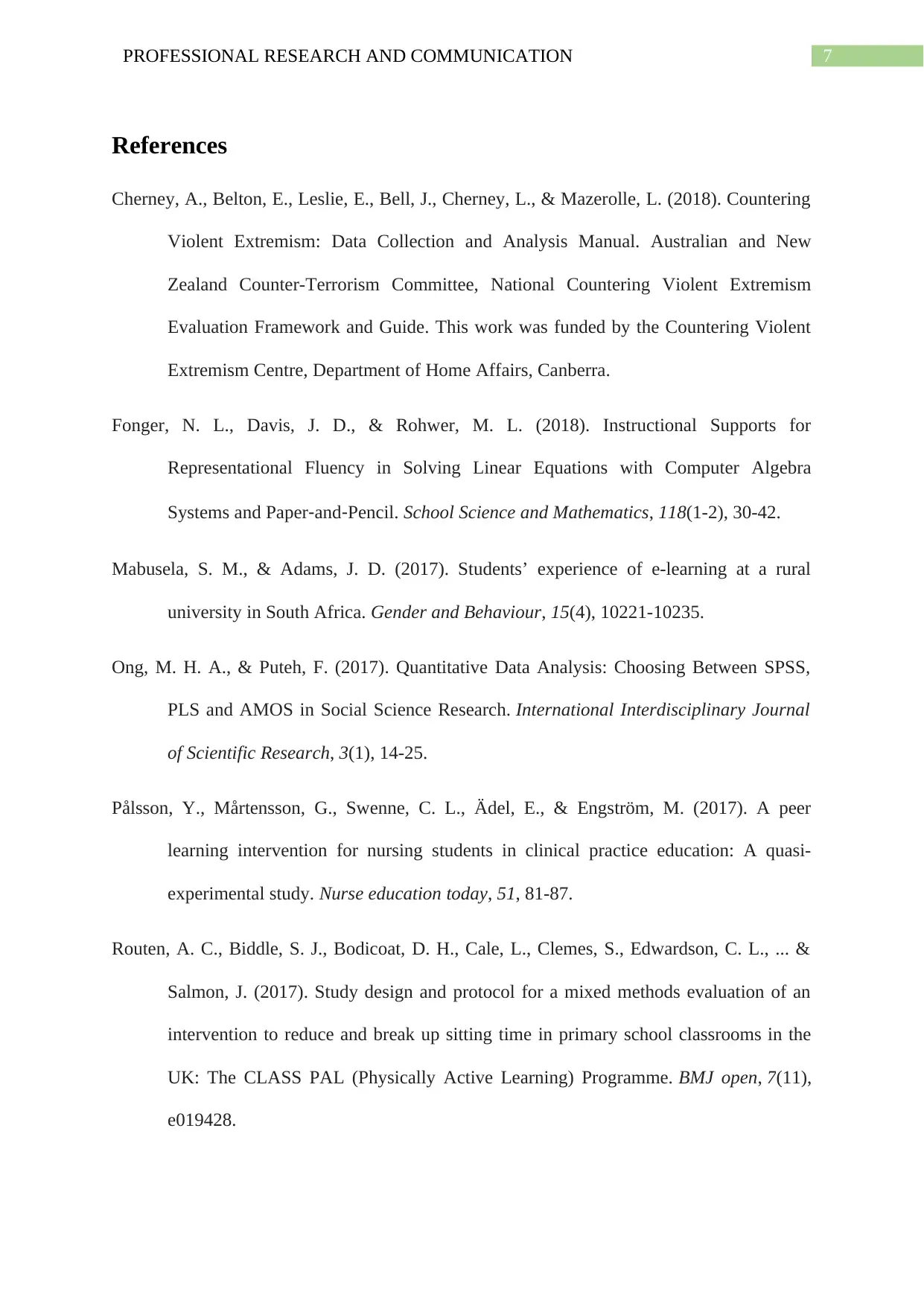
7PROFESSIONAL RESEARCH AND COMMUNICATION
References
Cherney, A., Belton, E., Leslie, E., Bell, J., Cherney, L., & Mazerolle, L. (2018). Countering
Violent Extremism: Data Collection and Analysis Manual. Australian and New
Zealand Counter-Terrorism Committee, National Countering Violent Extremism
Evaluation Framework and Guide. This work was funded by the Countering Violent
Extremism Centre, Department of Home Affairs, Canberra.
Fonger, N. L., Davis, J. D., & Rohwer, M. L. (2018). Instructional Supports for
Representational Fluency in Solving Linear Equations with Computer Algebra
Systems and Paper‐and‐Pencil. School Science and Mathematics, 118(1-2), 30-42.
Mabusela, S. M., & Adams, J. D. (2017). Students’ experience of e-learning at a rural
university in South Africa. Gender and Behaviour, 15(4), 10221-10235.
Ong, M. H. A., & Puteh, F. (2017). Quantitative Data Analysis: Choosing Between SPSS,
PLS and AMOS in Social Science Research. International Interdisciplinary Journal
of Scientific Research, 3(1), 14-25.
Pålsson, Y., Mårtensson, G., Swenne, C. L., Ädel, E., & Engström, M. (2017). A peer
learning intervention for nursing students in clinical practice education: A quasi-
experimental study. Nurse education today, 51, 81-87.
Routen, A. C., Biddle, S. J., Bodicoat, D. H., Cale, L., Clemes, S., Edwardson, C. L., ... &
Salmon, J. (2017). Study design and protocol for a mixed methods evaluation of an
intervention to reduce and break up sitting time in primary school classrooms in the
UK: The CLASS PAL (Physically Active Learning) Programme. BMJ open, 7(11),
e019428.
References
Cherney, A., Belton, E., Leslie, E., Bell, J., Cherney, L., & Mazerolle, L. (2018). Countering
Violent Extremism: Data Collection and Analysis Manual. Australian and New
Zealand Counter-Terrorism Committee, National Countering Violent Extremism
Evaluation Framework and Guide. This work was funded by the Countering Violent
Extremism Centre, Department of Home Affairs, Canberra.
Fonger, N. L., Davis, J. D., & Rohwer, M. L. (2018). Instructional Supports for
Representational Fluency in Solving Linear Equations with Computer Algebra
Systems and Paper‐and‐Pencil. School Science and Mathematics, 118(1-2), 30-42.
Mabusela, S. M., & Adams, J. D. (2017). Students’ experience of e-learning at a rural
university in South Africa. Gender and Behaviour, 15(4), 10221-10235.
Ong, M. H. A., & Puteh, F. (2017). Quantitative Data Analysis: Choosing Between SPSS,
PLS and AMOS in Social Science Research. International Interdisciplinary Journal
of Scientific Research, 3(1), 14-25.
Pålsson, Y., Mårtensson, G., Swenne, C. L., Ädel, E., & Engström, M. (2017). A peer
learning intervention for nursing students in clinical practice education: A quasi-
experimental study. Nurse education today, 51, 81-87.
Routen, A. C., Biddle, S. J., Bodicoat, D. H., Cale, L., Clemes, S., Edwardson, C. L., ... &
Salmon, J. (2017). Study design and protocol for a mixed methods evaluation of an
intervention to reduce and break up sitting time in primary school classrooms in the
UK: The CLASS PAL (Physically Active Learning) Programme. BMJ open, 7(11),
e019428.
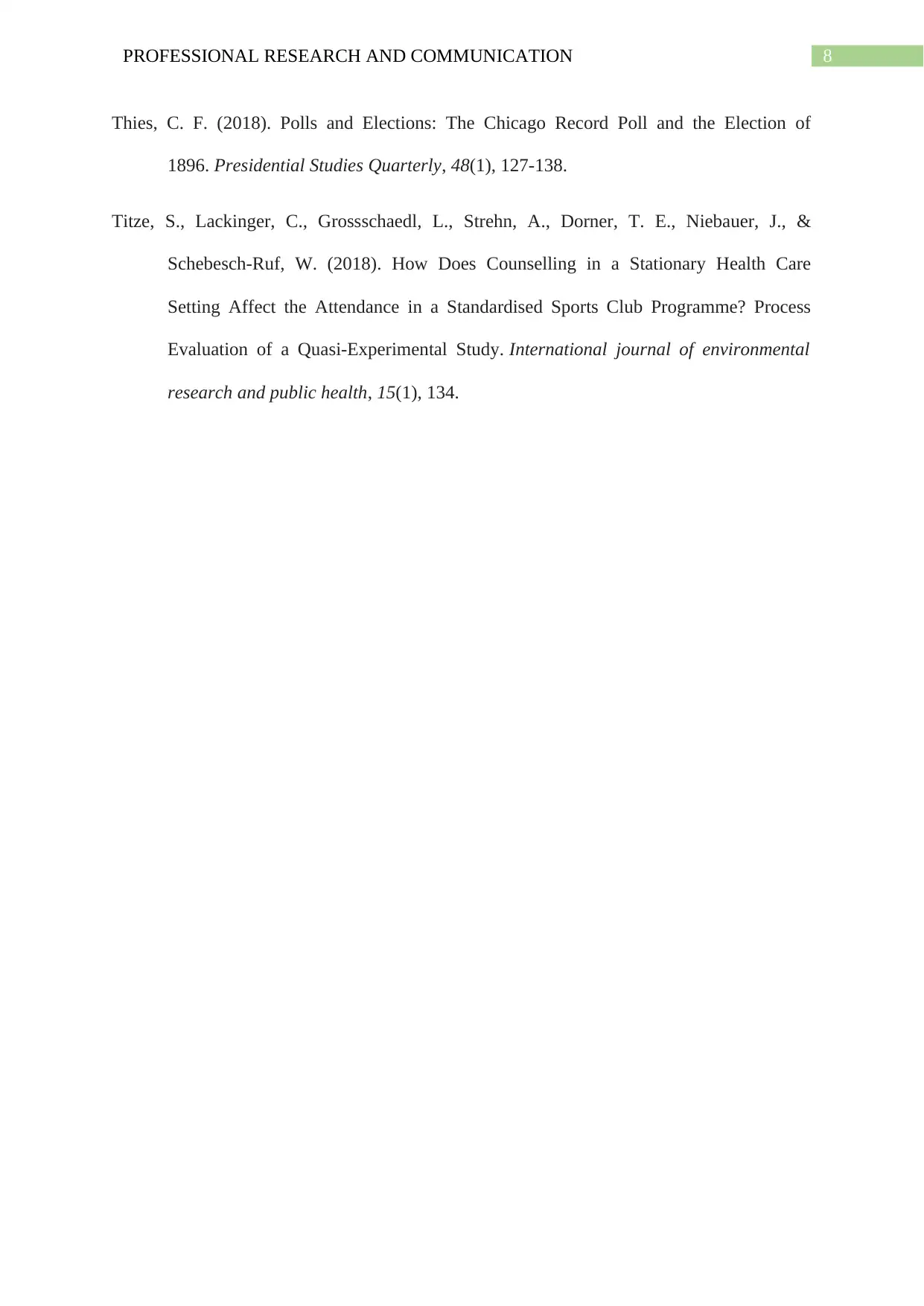
8PROFESSIONAL RESEARCH AND COMMUNICATION
Thies, C. F. (2018). Polls and Elections: The Chicago Record Poll and the Election of
1896. Presidential Studies Quarterly, 48(1), 127-138.
Titze, S., Lackinger, C., Grossschaedl, L., Strehn, A., Dorner, T. E., Niebauer, J., &
Schebesch-Ruf, W. (2018). How Does Counselling in a Stationary Health Care
Setting Affect the Attendance in a Standardised Sports Club Programme? Process
Evaluation of a Quasi-Experimental Study. International journal of environmental
research and public health, 15(1), 134.
Thies, C. F. (2018). Polls and Elections: The Chicago Record Poll and the Election of
1896. Presidential Studies Quarterly, 48(1), 127-138.
Titze, S., Lackinger, C., Grossschaedl, L., Strehn, A., Dorner, T. E., Niebauer, J., &
Schebesch-Ruf, W. (2018). How Does Counselling in a Stationary Health Care
Setting Affect the Attendance in a Standardised Sports Club Programme? Process
Evaluation of a Quasi-Experimental Study. International journal of environmental
research and public health, 15(1), 134.
⊘ This is a preview!⊘
Do you want full access?
Subscribe today to unlock all pages.

Trusted by 1+ million students worldwide
1 out of 9
Related Documents
Your All-in-One AI-Powered Toolkit for Academic Success.
+13062052269
info@desklib.com
Available 24*7 on WhatsApp / Email
![[object Object]](/_next/static/media/star-bottom.7253800d.svg)
Unlock your academic potential
Copyright © 2020–2025 A2Z Services. All Rights Reserved. Developed and managed by ZUCOL.




